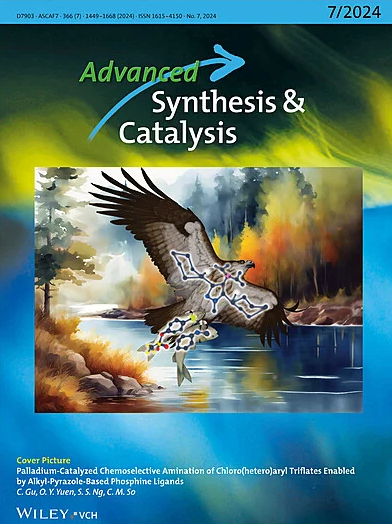通过碳正离子中间体的电化学脱羧功能化
IF 4
2区 化学
Q2 CHEMISTRY, APPLIED
引用次数: 0
摘要
与自由基介导的电化学脱羧偶联相比,通过碳正离子中间体(Hofer - Moest途径)进行的电化学脱羧功能化释放出独特的反应性和选择性。这些原位生成的碳阳离子可以被不同的亲核试剂捕获或被消除形成烯烃,这大大扩大了合成的通用性。本文系统地回顾了自2019年以来电化学Hofer - Moest型反应的进展,并根据成键事件(C _ _ _ N, C _ _ O, C _ _ P, C _ _ F, C _ _ C和C _ l _ C)对转化进行了分类。除了总结关键突破之外,它还提供了对当前局限性的平衡评估,以描述这些方法的范围和适用性。最后,对这一新兴领域存在的挑战进行了概述,并提出了未来的研究方向。本文章由计算机程序翻译,如有差异,请以英文原文为准。
Electrochemical Decarboxylative Functionalizations through Carbocation Intermediates
In contrast to radical‐mediated electrochemical decarboxylative couplings, electrochemical decarboxylative functionalizations proceeding through carbocation intermediates (Hofer‐Moest pathway) unlock unique reactivity and selectivity. These in situ‐generated carbocations can be trapped by diverse nucleophiles or undergo elimination to form alkenes, significantly expanding synthetic versatility. This review systematically surveys advances in electrochemical Hofer‐Moest‐type reactions since 2019, categorizing transformations by bond‐forming events (CN, CO, CP, CF, CC, and CC). Beyond summarizing key breakthroughs, it also provide balanced evaluation of current limitations to delineate the scope and applicability of these methods. Finally, persistent challenges are outlined and future research directions in this emerging field is proposed.
求助全文
通过发布文献求助,成功后即可免费获取论文全文。
去求助
来源期刊

Advanced Synthesis & Catalysis
化学-应用化学
CiteScore
9.40
自引率
7.40%
发文量
447
审稿时长
1.8 months
期刊介绍:
Advanced Synthesis & Catalysis (ASC) is the leading primary journal in organic, organometallic, and applied chemistry.
The high impact of ASC can be attributed to the unique focus of the journal, which publishes exciting new results from academic and industrial labs on efficient, practical, and environmentally friendly organic synthesis. While homogeneous, heterogeneous, organic, and enzyme catalysis are key technologies to achieve green synthesis, significant contributions to the same goal by synthesis design, reaction techniques, flow chemistry, and continuous processing, multiphase catalysis, green solvents, catalyst immobilization, and recycling, separation science, and process development are also featured in ASC. The Aims and Scope can be found in the Notice to Authors or on the first page of the table of contents in every issue.
 求助内容:
求助内容: 应助结果提醒方式:
应助结果提醒方式:


